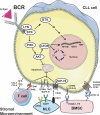Targeting the B cell receptor pathway in chronic lymphocytic leukemia
- PMID: 22616724
- PMCID: PMC4557770
- DOI: 10.3109/10428194.2012.695781
Targeting the B cell receptor pathway in chronic lymphocytic leukemia
Abstract
The B cell receptor (BCR) pathway plays a crucial role in the survival, proliferation and trafficking of chronic lymphocytic leukemia (CLL) cells. Inhibitors of the key kinases in this pathway, including spleen tyrosine kinase (SYK), mammalian target of rapamycin (mTOR), phosphoinositide 3'-kinase (PI3K) and Bruton's tyrosine kinase (BTK), have been found in preclinical models to decrease CLL cell viability both directly and indirectly through modulation of the microenvironment. Recently, oral agents targeting each of these kinases have been explored in early phase clinical trials in patients with CLL. BCR pathway antagonists appear to be highly active in relapsed/refractory CLL, independent of high-risk disease markers such as del(17p). These agents have shown a unique pattern of inducing early transient lymphocytosis, which typically is associated with nodal response. Here, we review the biology of the BCR, the kinases within this pathway and their interaction with the CLL microenvironment. We also discuss data from recent and ongoing clinical trials of BCR antagonists. We address the development of potential biomarkers for response to these agents such as ZAP-70, IGHV status and CCL3, and discuss where these exciting new drugs may fit in the evolving landscape of CLL therapy.
Figures

References
-
- Chiorazzi N, Rai KR, Ferrarini M. Chronic lymphocytic leukemia. The New England journal of medicine. 2005;352:804–815. - PubMed
-
- Burger JA. Nurture versus nature: the microenvironment in chronic lymphocytic leukemia. Hematology / the Education Program of the American Society of Hematology. American Society of Hematology. Education Program. 2011;2011:96–103. - PubMed
-
- Stevenson FK, Caligaris-Cappio F. Chronic lymphocytic leukemia: revelations from the B-cell receptor. Blood. 2004;103:4389–4395. - PubMed
Publication types
MeSH terms
Substances
Grants and funding
LinkOut - more resources
Full Text Sources
Other Literature Sources
Research Materials
Miscellaneous
